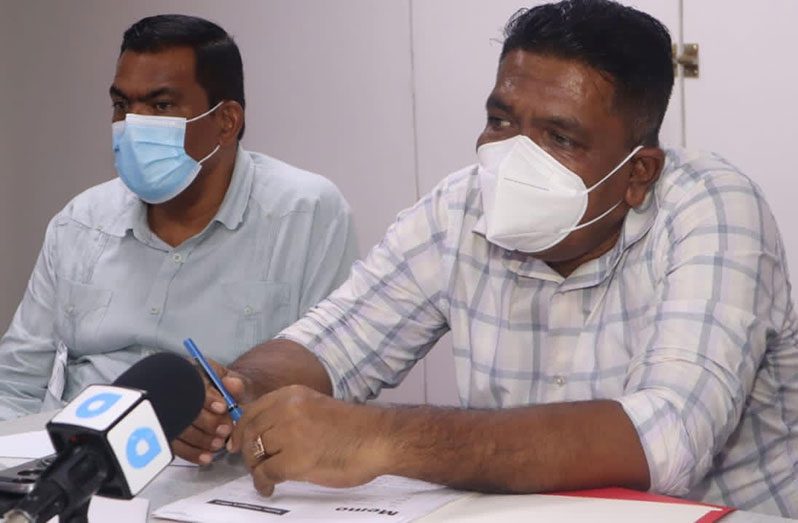–claim delivered product is ‘green’ and ‘damaged’
EMPHASISING the need for a higher quality of paddy, several prominent millers in Region Two, on Tuesday, called on rice farmers to invest more time in their crop and to devote lots of energy to controlling the level of paddy-bug infestations.
The millers were, at the time, meeting with the Minister of Agriculture, Zulfikar Mustapha, in the Regional Democratic Council (RDC) boardroom at Anna Regina.

The owner of Caricom Rice Mills, Tamesh Jagmohan, informed the minister that despite the low grades, millers have added $100 to the $2900 that was previously offered for a bag of paddy. It was recently announced that rice farmers are being offered $3000 a bag for grade A paddy.
Jagmohan said that his mills have been getting “green” and “damaged” paddy. He explained that low grades will affect the overall profit margin of the company.
He also told the minister and his team that he thinks the prices offered to the region’s farmers are fair, based on the level of the production chain.
“The prices we are offering…we did a lot of calculations…looking at cost of production on an hourly basis, it’s a fair price. We are encountering issues like green and damage paddy and so on, and it affects our overall profit margin. Our prices, to me, are very competitive compared to the prices we are getting overseas. We’ve gone up to $100 per bag, yet the quality remains the same,” Jagmohan explained.

Chief Executive Officer and Director of Imam Bacchus and Sons Limited, Aadil Baksh, also said that he believes the rice farmers are being offered a good price for their harvest. He commended the minister for reaching out to millers, an act that was never done by his predecessors
Baksh said for several crops, the prices for a bag of grade A paddy remained the same. However, for this crop, he said there has been an increase of $100, which he commented is fair compared to previous crops. He also said that based on the reduction in VAT on certain agriculture items, millers were able to benefit and this resulted in the increase in price.
Baksh, however, said that the prices millers are offering depend on the international market prices and thus far, these have been varying. This, he said, has put millers at a disadvantage since they cannot commit to an increase of price without knowing the prices offered internationally.

He also commended the minister for proposing a 35% reduction in the boat freight. However, he said most millers use a ship to export their rice and not the ferry.
Baksh announced that his mill will be rewarding rice farmers with better grades and higher prices.
During the meeting with the millers, Minister Mustapha said that the Government of Guyana is prepared to extend concessions with the intention that the benefits will trickle down to the rice farmers.
“As it stands now, I think the factor that determines the prices in Region Two is transportation. I have a proposal. We can look at the consideration of the ferry. In the islands, we were able to give special concessions to the farmers there and I want to extend the same concession to the farmers and millers on the Essequibo Coast,” he said.
Millers have indicated to the minister that they would discuss the proposal among themselves and respond within a few days.
Meanwhile, several rice farmers told the minister that their fields have a high prevalence of paddy bugs. The farmers met with the minister earlier in the day.
This situation, they said, has resulted in the production of lower grades which has led to the low prices being offered by the millers.
President of the Guyana Rice Exporters and Millers Association (GREMA), Rajindra Persaud, said that Essequibo farmers need to practice block planting to control paddy-bug infestations.
He explained that if farmers can irrigate their fields in a shorter time, within six weeks the entire area can be cultivated and the bugs would not be able to move from field to field.
Persaud said that during interactions with millers, concerns were raised about the cost of the ferry and the restriction at the Demerara Habour Bridge which are affecting the transport of the finished product to Georgetown.
“There is a weight limit at the bridge, so normally when a truck leaves Essequibo, they have to discharge at West Demerara, take off some of the load, cross the bridge, discharge that load, cross back over the bridge, load the remaining stuff and then proceed to the wharf. It’s very tedious and expensive,” Persaud said.



.jpg)









